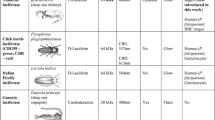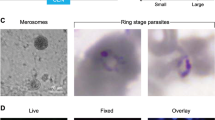Abstract
Malaria hypnozoites are dormant parasite stages that reside inside hepatocytes. Upon activation, these stages can resume growth, causing new episodes of blood stage malaria infection. This chapter describes a fast and sensitive protocol for the detection of bioluminescent (BL) hypnozoites in vitro. Using transgenic Plasmodium cynomolgi parasites that differentially express the BL reporter proteins firefly luciferase and the ultrabright NanoLuc, hypnozoites can be distinguished from liver stage schizonts. This robust method sets the stage for implementation in large-scale drug screening platforms with the aim to find new compounds that eliminate hypnozoites.
Access this chapter
Tax calculation will be finalised at checkout
Purchases are for personal use only
Similar content being viewed by others
References
Krotoski WA, Garnham PC, Bray RS et al (1982) Observations on early and late post-sporozoite tissue stages in primate malaria. I. Discovery of a new latent form of Plasmodium cynomolgi (the hypnozoite), and failure to detect hepatic forms within the first 24 hours after infection. Am J Trop Med Hyg 31(1):24–35
Dembele L, Gego A, Zeeman AM et al (2011) Towards an in vitro model of plasmodium hypnozoites suitable for drug discovery. PLoS One 6(3):e18162. https://doi.org/10.1371/journal.pone.0018162
Roth A, Maher SP, Conway AJ et al (2018) A comprehensive model for assessment of liver stage therapies targeting Plasmodium vivax and Plasmodium falciparum. Nat Commun 9(1):1837. https://doi.org/10.1038/s41467-018-04221-9
Voorberg-van der Wel AM, Zeeman AM, Nieuwenhuis IG et al (2020) Dual-luciferase-based fast and sensitive detection of malaria Hypnozoites for the discovery of Antirelapse compounds. Anal Chem 92(9):6667–6675. https://doi.org/10.1021/acs.analchem.0c00547
Gupta DK, Dembele L, Voorberg-van der Wel A et al (2019) The Plasmodium liver-specific protein 2 (LISP2) is an early marker of liver stage development. Elife 8. https://doi.org/10.7554/eLife.43362
Hall MP, Unch J, Binkowski BF et al (2012) Engineered luciferase reporter from a deep sea shrimp utilizing a novel imidazopyrazinone substrate. ACS Chem Biol 7(11):1848–1857. https://doi.org/10.1021/cb3002478
Feldmann AM, Ponnudurai T (1989) Selection of Anopheles stephensi for refractoriness and susceptibility to Plasmodium falciparum. Med Vet Entomol 3(1):41–52. https://doi.org/10.1111/j.1365-2915.1989.tb00473.x
Guguen-Guillouzo C, Campion JP, Brissot P et al (1982) High yield preparation of isolated human adult hepatocytes by enzymatic perfusion of the liver. Cell Biol Int Rep 6(6):625–628. https://doi.org/10.1016/0309-1651(82)90187-4
Noulin F, Borlon C, van den Eede P et al (2012) Cryopreserved reticulocytes derived from hematopoietic stem cells can be invaded by cryopreserved Plasmodium vivax isolates. PLoS One 7(7):e40798. https://doi.org/10.1371/journal.pone.0040798
Voorberg-van der Wel AM, Zeeman AM, Nieuwenhuis IG et al (2020) A dual fluorescent Plasmodium cynomolgi reporter line reveals in vitro malaria hypnozoite reactivation. Commun Biol 3:7. https://doi.org/10.1038/s42003-019-0737-3
Acknowledgments
This work was supported by the Bill & Melinda Gates Foundation grant OPP1141292.
Author information
Authors and Affiliations
Corresponding author
Editor information
Editors and Affiliations
Rights and permissions
Copyright information
© 2022 The Author(s), under exclusive license to Springer Science+Business Media, LLC, part of Springer Nature
About this protocol
Cite this protocol
Voorberg-van der Wel, A.M., Zeeman, AM., Nieuwenhuis, I.G., van der Werff, N.M., Kocken, C.H.M. (2022). Dual-Luciferase-Based Fast and Sensitive Detection of Malaria Hypnozoites for the Discovery of Anti-relapse Compounds. In: Kim, SB. (eds) Bioluminescence. Methods in Molecular Biology, vol 2524. Humana, New York, NY. https://doi.org/10.1007/978-1-0716-2453-1_31
Download citation
DOI: https://doi.org/10.1007/978-1-0716-2453-1_31
Published:
Publisher Name: Humana, New York, NY
Print ISBN: 978-1-0716-2452-4
Online ISBN: 978-1-0716-2453-1
eBook Packages: Springer Protocols




